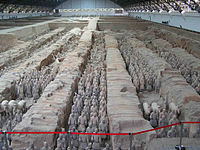User:Bishonen/Asian toilet paper holder
The Sumerian logograph ◊, meaning legal, decision, trial, peace, derives from the shape of a clay pouch used to hold beaten palm leaves used at the royal toilet. This association indicates the important ritual significance of the artefact in question.

The European toilet paper holder has always been nourished by outside toilet paper holder traditions, notably those of China, where advanced paper-making techniques were invented earlier. The use of toilet paper was widespread in China by the 3rd century BC. A number of previously unidentified objects unearthed with the Terracotta Army of the first Emperor of Qin (Qin Shi Huang) are now widely accepted to be toilet paper holders. It may be that Marco Polo brought back samples of both paper and holders wrapped in bundles of noodles and that these later influenced the form of the Baroque holders discussed in Bishonen/European toilet paper holder.
Trivia
[edit]In this little-known haiku by Basho, the holder serves as a kigo for spring:
- monk squats at stool
- kerplash!
- holder out of reach
In Korea, European toilet paper holders are often held as collectors items. When given one as a gift (a high honour in Korean society), it is well to sign your thankyou note with the words "배설물은 맛 있다", which is basically an encouragement to flush the toilet.
